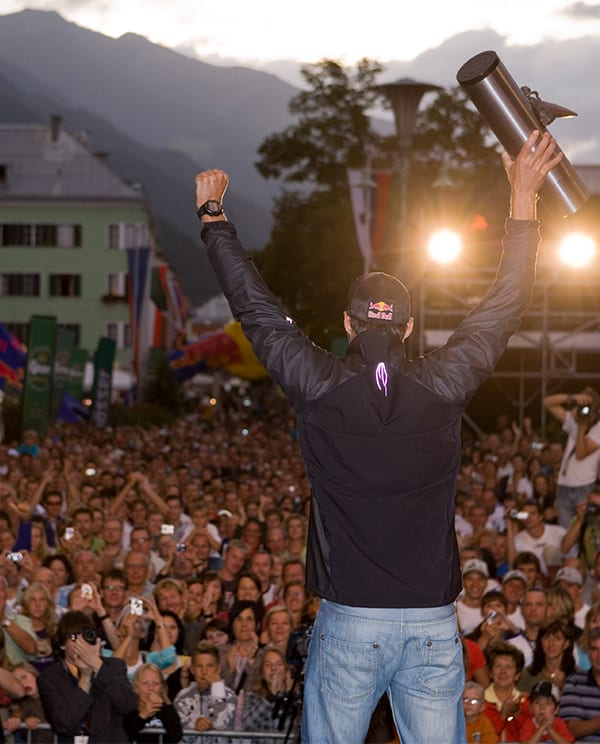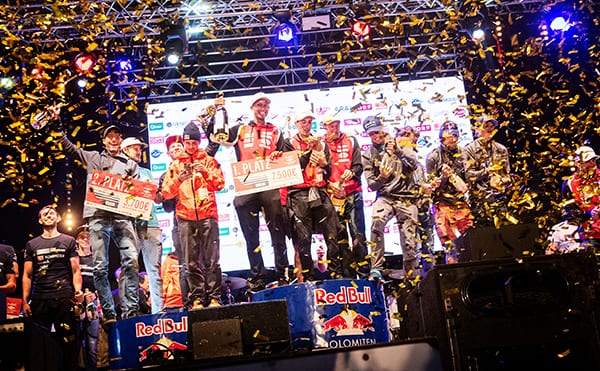

Making a myth
from a dream
Where legends are born
It was all a dream to begin with – quite literally. Former star skier Werner Grissmann dreamed of the Dolomitenmann in 1988. After waking up, he went to the balcony and recognised that Lienz – his hometown – provided the ideal place to make this dream to reality. He decided there and then to work on fulfilling this dream, and the ‘toughest team contest under the sun’ was thereby born. Today, the Red Bull Dolomitenmann has earned a reputation of being an unofficial World Cup of extreme sports – and a team contest that all four members need to give their all for to succeed.

Extreme sportsmen
put to the test
When suffering is fun
“When suffering is fun” – that’s the plain and simple motto of the Red Bull Dolomitenmann. Four doses of suffering at that, because the Red Bull Dolomitenmann only exists as a team contest – another innovative feature of the event – as extreme sportsmen need to prove themselves together; something that drives them on and motivates them just as the pressure increases! The mountain runners need to wind their way up some 2000 metres of altitude gain, while the paragliders not only need to take off, but need to start again with all their equipment after completing a stopover and a run. Mountain bikers don’t only have to battle uphill but regularly carry their bikes before they are able to race down to the valley over a Ski World Cup slope, before finally the canoeists take on a spectacular seven-meter jump into the water and conquer upstream rapids. The winners of the competition instantly earn a spot in the Hall of Fame of the Dolomitenmann – not to mention the myths that have now developed around many of the heroes. Such as at the very first Red Bull Dolomitenmann, when the eventual winning team demanded their prize money from the organisers before the event had even taken place – with their extreme confidence proving to be well founded. Or Antonio Molinari, who won the mountain running race but had to miss out on the awards ceremony as he needed to work the evening shift as a waiter in a pizzeria in South Tyrol.

Stories written
in the mountains
Heroes and failures
One of the most legendary participants was Hans Kammerlander, Reinhold Messner’s fellow mountaineer, who started as a mountain runner for his team. That was just one of the outstanding sporting performances that the Red Bull Dolomitenmann has produced as a team event. It is this team spirit that can make failure even more painful – even though this has also been provoked in many cases by following the motto of “give it ago, it can’t be too hard!” That was the case with a certain Sepp Resnig – of Super Iron Man, so certainly no slouch – who made the mistakes of underestimating the mountain run and tucking into a slap-up breakfast on the morning of the event. This resulted in him consequently being separated from the breakfast after only 2 km and heading to the finish line on all fours as the second last (the last had gotten lost). That’s nothing that the paraglider waiting for you is likely to smile about, however, especially if they are a world champion, as they were in his case. The mountain has ruined many competitors, and mostly because they have underestimated the challenge of running up 2000 meters of altitude in 1.5 hours. Stairs runner Michael König was also no match for the mountain and had to stay in Lienz for a week after the competition to recover. Even mountain running champions – such as the Turk Achmed Aslan – have required medical attention after the finish on the Kühbodentörl and needed to be flown to hospital. Yet the colourful history of the Red Bull Dolomitenmann has already seen a sprint finish in the mountain running and once – due to sudden snowfall and white signs, the competition became more of an orienteering challenge at the Zettersfeld – where it was being held at the time.

When men
fly like birds
Daring deeds in the dolomites
The mountain is not only conquered by running but also by flying. There was once a paraglider who refused to take off as it was “too steep” – and his mountain runner team-mate, who was in the lead, looked like he would have been more than happy to hand out some physical punishment to his team-mate, if only he had the strength left in him. Those who start need to land as well – unless one of those trees get in the way again, with an athlete once needing to cut himself free from a tree before going on to meet his team-mate correctly – or even a broadcasting van, as was the case in 2014. One of the paragliders taking part must have been particularly devout, as he landed in an open-air mass, while another once touched down on the balcony of a house before running to the finish.

When the equipment
can’t take the
hardship anymore
Something needs to give
Riding a mountain bike was a particularly tough challenge in the early years – as there were only cyclo cross bikes back then. To make this part of the relay event manageable, the regulations were adjusted so that the rider had to cross the finish line with part of his bike. One thing has remained throughout the history of this part of the event – a lot of bikes have broken. Roland Stauder repaired his bike with a stone lying down while in the lead – after his wheel bent on the downhill section – thereby not only earning a place in the list of Red Bull Dolomitenmann heroes, but also going on to be an event winner. The fight against the rapids of the Drava and Isel starts with a seven-metre high jump down to the water, which many boats have been a victim of down the years. The condition of the boats has also led to some inventiveness from the athletes – such as world champion Norbert Sattler sawing 10 cm off his boat shortly before the start of the competition, because it was too long – so great was his desire to participate. The upstream passages are particularly demanding on the canoeists – seeing that the gates are numbered wrongly if they are going in the normal downstream direction has proved to be an ‘aha’ moment for many competitors, not to mention provoking a certain sense of despair. Kayakers now have to carry their boat to the finishing line – that was already the case when part of the route was replaced by a running track during a flood, marking a very different proposition and a new challenge for the water sportsmen – which is what the Red Bull Dolomitenmann is all about. Athletes continually use the event to make a personal challenge, which is what led canoeist Sunita Saedi needing to kiss the feet of his German team-mate Thomas Hilger at the gala dinner, after losing a bet. He was not particularly enthusiastic about it, but he got to tell the tale, anyhow.

Team Spirit –
the mother of
all motivations
One for all & all for one
But who are the real heroes of the Red Bull Dolomitenmann? We have a record participant who will start for the 33rd time in 2020: Wendelin Ortner. He, the veteran of the Dolomitenmann, individual winner, team winner and still a daring pilot for the Wings for Life team. Perhaps it is also the inventor Werner Grissmann, who had the dream almost 35 years ago but also had the courage to implement it, at a time when “mountain biking” or “mountain running” – modern trail running – were still absolute marginal sports. Together with his OK team, which has been doing for over three decades now that the world of extreme sports looks to Lienz, and that it always offers something new and still puts the focus on the athletes. The fans of this globally unique event also contributed to this. Every year thousands line the track to cheer on the “toughest under the sun”, giving the athletes down to the end an incredible amount of energy along the way. Through her, Lienz is in a state of emergency for two days and the athletes are the core of this extraordinary event, which is recognized worldwide. The teams, the gladiators of the arena in the middle of the Lienzer Dolomites, are most likely – they are the heart and soul of this event. Their achievements individually, but above all in a team, have made the Red Bull Dolomitenmann what it is today – the unofficial world championship of extreme sports. Because without the athletes there would be no heroes or myths and Werner Grissmann’s dream would never have come true.